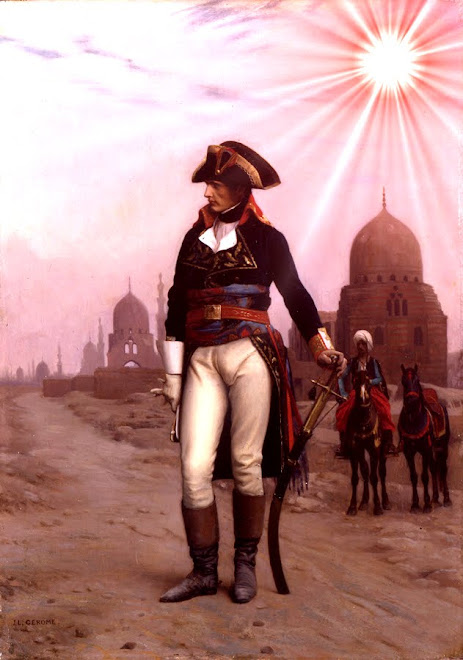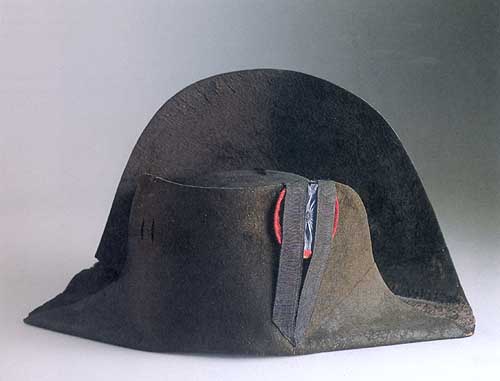SIC TRANSIT GLORIA MUNDI - RETREAT FROM MOSCOW
by RICHARD CATON WOODVILLE (1911)
Richard Caton Woodville was a prolific painter of historical scenes. He was born on January 7th 1856 and grew up when Britain was at the height of Empire. Not surprisingly, his detailed and evocative works became extremely popular. My favourite, a copy of which I am lucky enough to possess, is his Retreat From Moscow.
At the centre of the painting is a thoughtful and troubled Napoleon, watching his famous eagles being destroyed by fire so that the closely pursuing Russians would not be able to snatch them as trophies. Not all the eagles met this fate, a few were taken all the way back to France by the most stalwart members of the Imperial Guard, clutched closely to their hearts, literally in one case.
The scene is the Berezina River after General Eble and his magnificent men had thrown two rickety bridges across the ice choked waters. In the turbulent swell up to their chests, they had gallantly put together the makeshift bridges, some of the men drifting off into oblivion when the freezing waters stilled their noble lifeblood in their veins. Sergeant Bourgogne recounts having heard that the Emperor himself handed them wine as they went about their task. What a disaster it was that the pontoon bridges had been so recently burnt so that their horse teams could be used to pull the last of the cannons!
It was the coldest Russian winter for a hundred years and the water in the Berezina should have been as hard as steel, but a sudden thaw meant it was almost impossible to cross without those bridges, especially for the stragglers in the Grand Army who were at death's door. Bourgogne himself, half-dead with cold and a recent victim of poisoning, dragged himself across one night in a lull amidst the fighting. Hundreds of others, unwilling to leave their fires could have done the same. In the end they were bombarded by Russian cannon fire and they all raced for the bridges at the same time. In the chaos, dozens were crushed and a veritable mountain of bodies soon clogged up the entrances to the bridges. Coignet and Bourgogne both say that the scene was so awful as men women, and even children, plunged into the icy river, they had to turn away. That nightmare vision haunted them both for the rest of their lives.
Although the prospect for the soldiers seem dire in Catin Woodville's painting, it was even worse than he depicted it. Many men had faces blackened by smoke from swirling campfires, the temperatures had been so low that they had to almost sit amongst the flames in order to warm themselves. They had red eyes having been half-blinded by the glare of the snow and the heat of the fires and clothes singed by the flames. Those who could still walk by this stage were very lucky. There was already a trail of corpses leading all the way back to Moscow.
Picart and Bourgogne had been lost amongst the wilds of the Lithuanian forest and only by following a couple of distant figures did they find a peasant hut where they were welcomed. Picart had been shot in the head during a recent episode with some Cossacks and had seemed demented to Adrien Bourgogone as they stumbled together through the thick snow. Cursing Napoleon, Picart seemed to have completely lost it and Bourgogne had been extremely worried for them both. But then Picart said :"If we find the Emperor everything will be all right." The old peasant woman sucked his wound clean after a musket ball fell from out of his makeshift hood. When there was a noise outside, Picart went outside with a firebrand and scared off a pack of wolves that had literally been at the door. By now many packs would have been used to the taste of human flesh and aware of the extreme vulnerability of the stragglers in the Grand Army.
In this desolate forested wilderness the two soldiers were inordinately lucky to find themselves amidst a family of Francophiles. The head of the family, an old man, almost bowed his head to the floor when he heard the name "'Napoleon" and he was over the moon when he was given a commander's cross with the Emperor's portrait upon it. Pressing it to his lips and heart he indicated the reverence with which he viewed the treasured item.
So, more than a thousand miles from Paris, in the furthest back of beyond, a humble peasant had not only heard about Napoleon, he held him in the utmost esteems and venerated even his image. Such was the Emperor's magic, such was his spell.
Behind Napoleon in the painting, as gaudily dressed as usual was Murat, King of Naples, the Emperor's brother-in-law. He has a haughty aspect and he certainly fancied himself. Although he had saved the day at Eylau with a magnificent charge amongst the snow, leading his splendid throng of sabres into the Russian centre and carving them up on the way in and on the way out, he was to prove a disaster for his comrades in 1812. Having married into the Bonaparte clan, he was a 'prince of the blood' in more ways than one and he was given command of the remnants of the Army when Napoleon returned to Paris after the Malet Conspiracy. Already, having been surprised by Kutuzov's Russians at Winkowo, which was the initial cause of the Retreat, and having proved useless as Commander of the cavalry - he kept his forces bunched together and on the qui vivre all the time so that the troopers could neither rest properly nor forage - he had overseen the destruction of 99% of the cavalry. Only a Doomed Squadron of a few hundred remained with Generals acting as Colonels and Captains acting as troopers. When Bourgogne heard Murat was in charge he had grave forebodings. In the event, Murat fled to Naples and Eugene took command as he ought to have done in the first place.
Caton Woodville indicates all this by placing a cavalryman on foot in the foreground. By now over 50,000 horses had succumbed to the cold, to eating green rye or to the storm back in June which had killed 10,000 of them overnight. The figure still looks like a soldier when in fact most of the survivors in the Grand Army were now dressed in rags. Any old fur or item of apparel, even women's clothing, was wrapped around freezing shoulders or frostbitten feet. Many had lost their shoes or boots and their swollen feet could only be covered by wrapping rags around them.
In the background smoke swirls in the leaden sky as if carrying away the greatness of an Empire. Sic Transit Gloria Mundi.
C. John Tarttelin FINS 2011
A SOULADREAM PRODUCTION







No comments:
Post a Comment